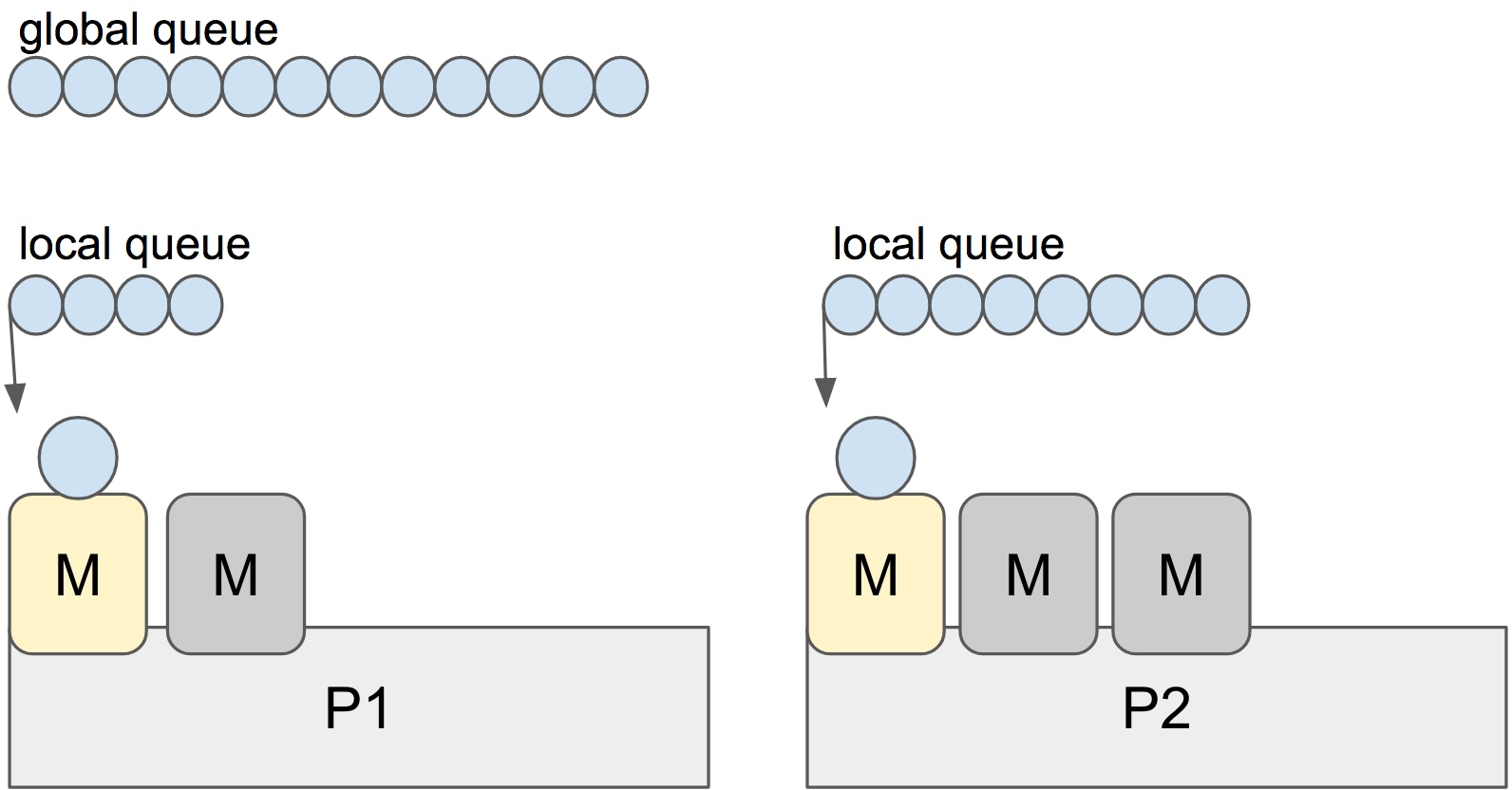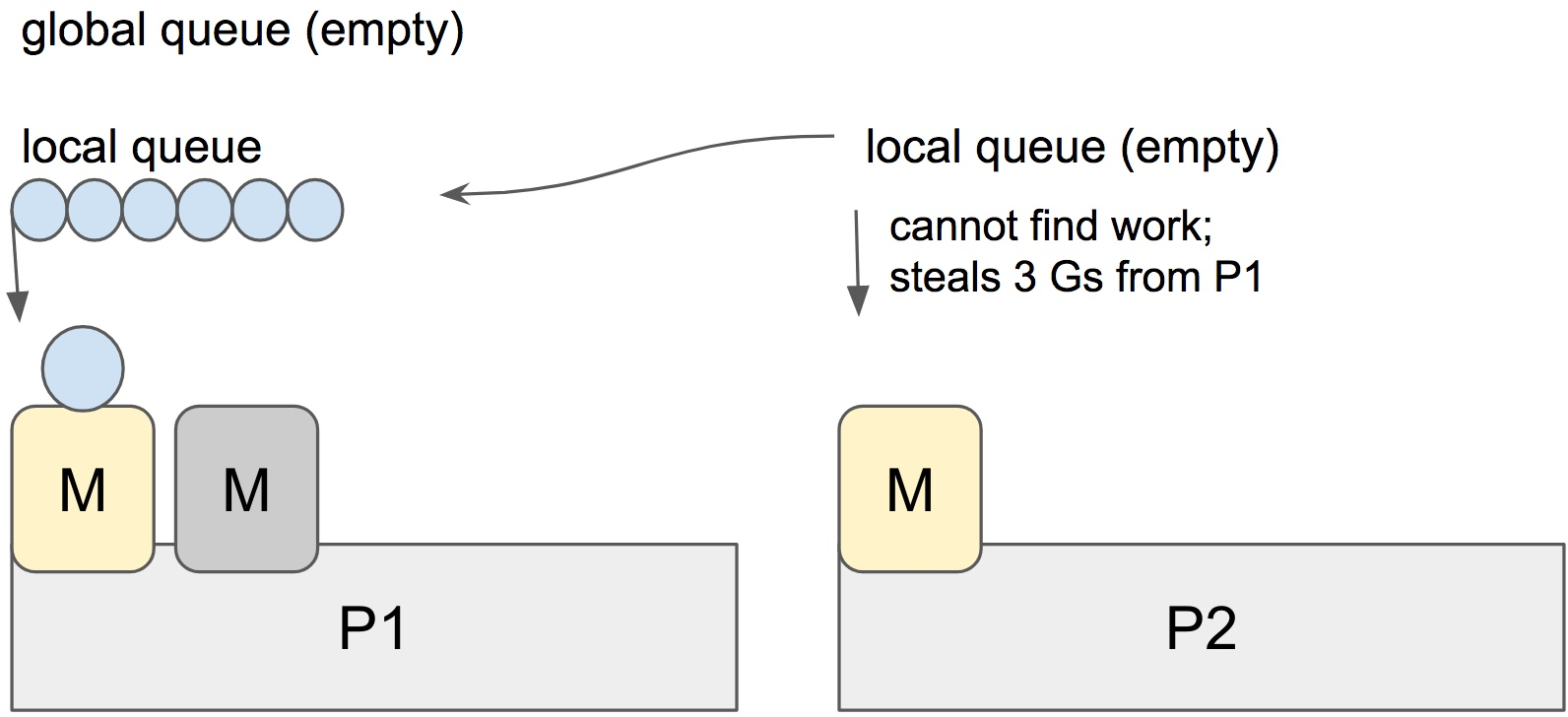小结:
1、多核处理器 从其他核的任务队列中偷取任务
新建goroutine 与饥饿模式
Go's work-stealing scheduler · rakyll.org https://rakyll.org/scheduler/
Go's work-stealing scheduler
Sun, Jul 16, 2017
Go scheduler’s job is to distribute runnable goroutines over multiple worker OS threads that runs on one or more processors. In multi-threaded computation, two paradigms have emerged in scheduling: work sharing and work stealing.
- Work-sharing: When a processor generates new threads, it attempts to migrate some of them to the other processors with the hopes of them being utilized by the idle/underutilized processors.
- Work-stealing: An underutilized processor actively looks for other processor’s threads and “steal” some.
The migration of threads occurs less frequently with work stealing than with work sharing. When all processors have work to run, no threads are being migrated. And as soon as there is an idle processor, migration is considered.
Go has a work-stealing scheduler since 1.1, contributed by Dmitry Vyukov. This article will go in depth explaining what work-stealing schedulers are and how Go implements one.
Scheduling basics
Go has an M:N scheduler that can also utilize multiple processors. At any time, M goroutines need to be scheduled on N OS threads that runs on at most GOMAXPROCS numbers of processors. Go scheduler uses the following terminology for goroutines, threads and processors:
- G: goroutine
- M: OS thread (machine)
- P: processor
There is a P-specific local and a global goroutine queue. Each M should be assigned to a P. Ps may have no Ms if they are blocked or in a system call. At any time, there are at most GOMAXPROCS number of P. At any time, only one M can run per P. More Ms can be created by the scheduler if required.

Each round of scheduling is simply finding a runnable goroutine and executing it. At each round of scheduling, the search happens in the following order:
runtime.schedule() {
// only 1/61 of the time, check the global runnable queue for a G.
// if not found, check the local queue.
// if not found,
// try to steal from other Ps.
// if not, check the global runnable queue.
// if not found, poll network.
}
Once a runnable G is found, it is executed until it is blocked.
Note: It looks like the global queue has an advantage over the local queue but checking global queue once a while is crucial to avoid M is only scheduling from the local queue until there are no locally queued goroutines left.
Stealing
When a new G is created or an existing G becomes runnable, it is pushed onto a list of runnable goroutines of current P. When P finishes executing G, it tries to pop a G from own list of runnable goroutines. If the list is now empty, P chooses a random other processor (P) and tries to steal a half of runnable goroutines from its queue.

In the case above, P2 cannot find any runnable goroutines. Therefore, it randomly picks another processor (P1) and steal three goroutines to its own local queue. P2 will be able to run these goroutines and scheduler work will be more fairly distributed between multiple processors.
Spinning threads
The scheduler always wants to distribute as much as runnable goroutines to Ms to utilize the processors but at the same time we need to park excessive work to conserve CPU and power. Contradictory to this, scheduler should also need to be able to scale to high-throughput and CPU intense programs.
Constant preemption is both expensive and is a problem for high-throughput programs if the performance is critical. OS threads shouldn’t frequently hand-off runnable goroutines between each other, because it leads to increased latency. Additional to that in the presence of syscalls, OS threads need to be constantly blocked and unblocked. This is costly and adds a lot of overhead.
In order to minimize the hand-off, Go scheduler implements “spinning threads”. Spinning threads consume a little extra CPU power but they minimize the preemption of the OS threads. A thread is spinning if:
- An M with a P assignment is looking for a runnable goroutine.
- An M without a P assignment is looking for available Ps.
- Scheduler also unparks an additional thread and spins it when it is readying a goroutine if there is an idle P and there are no other spinning threads.
There are at most GOMAXPROCS spinning Ms at any time. When a spinning thread finds work, it takes itself out of spinning state.
Idle threads with a P assignment don’t block if there are idle Ms without a P assignment. When new goroutines are created or an M is being blocked, scheduler ensures that there is at least one spinning M. This ensures that there are no runnable goroutines that can be otherwise running; and avoids excessive M blocking/unblocking.
Conclusion
Go scheduler does a lot to avoid excessive preemption of OS threads by scheduling them to the right and underutilized processors by stealing, as well as implementing “spinning” threads to avoid high occurrence of blocked/unblocked transitions.
Scheduling events can be traced by the execution tracer. You can investigate what’s going on if you happen to believe you have poor processor utilization.
References
What Is Work Stealing? - Technipages https://www.technipages.com/what-is-work-stealing

What Is Work Stealing?
August 4, 2022 by Mel Hawthorne
Modern computers have multiple processing cores. Assuming there is enough processing so that each core can remain continuously busy. they will be assigned a queue of computational work items. Or threads to complete by the scheduler.
During executing these threads, it’s possible to spawn new threads or work items. These are separate threads that can be processed simultaneously. They may need to feed results back to the spawning programs or remain completely separate indefinitely. Typically, these child threads are assigned to the same processing core as the parent.
All this assumes that all the cores are kept busy. This will happen if no thread ends or new threads are spawned at the same rate or faster than existing threads end. In the real world, though, the long-term workload is rarely that simple, especially in end-user computing devices. Eventually, a processing core will likely complete all the assigned tasks. When this happens, rather than sitting idle and wasting potential performance, it instead checks on the work queues of the other processing cores and steals a work item from them.
Benefits and Downsides
Work stealing means that an idle processing core will actively search out work for it to complete. This prevents a potentially large fraction of the overall processor from sitting idle, which is helpful. Work stealing can come with some costs, though. For example, the new processing core will likely have to load any relevant data into its cache memory.
This can take time, especially if it has to be requested from system RAM rather than being served by a shared cache tier. It’s possible that the original processor would have been able to resume that work item in that timeframe, leading to faster overall execution. This can even be the case if the processing core from which the work item was stolen had never begun processing it. Some cached values may be identical between parent and child threads.
Implementations
Several programming languages have runtimes that can schedule work directly on dedicated processors. For example, the Cilk programming language, the Rust Tokio runtime, and the .Net Task Parallel Library can do this. Alternatively, the operating system may be in charge of scheduling actual processor time. With the program simply adding tasks to a pool of “worker threads,” which are themselves scheduled by the operating system.
This happens in systems where the program does not have dedicated direct access to processing cores but must share access with other processes. Extra care must be taken in this scenario to ensure that a thread isn’t repeatedly stolen as it sits idle.
There are various approaches to how work items are selected to be stolen. In the original concept, the approach was to choose another random core. If it had one or more work items in its queue, take the last one. Depending on the preference for whether a child process is immediately executed by the originating processor. Or, if it’s pushed to the processor’s queue and the parent process continues to be executed, the parent or child thread will be stolen.
It can all be summed up as Work Stealing, a load balancing technique that ensures that the word load is spread evenly among available processors. That way, all processors are doing something to help.
Conclusion
Work stealing is a process that happens automatically in multicore CPUs. Each core has a queue of tasks to perform. When a processor completes its tasks, it then steals another task from the queue of another processing core. This helps to prevent the processor from having some cores sit idle while others still have a queue of tasks to perform.
Guide to Work Stealing in Java | Baeldung https://www.baeldung.com/java-work-stealing


